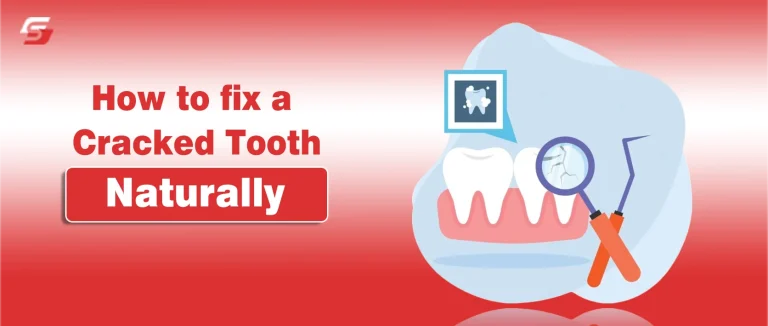Cracked teeth are one of the most common dental injuries, often occurring without immediate pain or visible signs. You also wonder if these cracks can heal naturally without seeing a dentist. The idea of avoiding dental treatment is appealing, especially when the damage seems minor, but the biological reality of tooth structure makes full natural healing extremely limited.
This article takes a realistic, scientifically grounded look at what can and cannot be done at home. You’ll learn how to manage minor cracks naturally, support enamel health, prevent infection, and understand exactly when professional dental care becomes non-negotiable.
What Happens When a Tooth Cracks
Understanding the structure of a tooth is crucial to comprehending its potential for healing. Enamel, dentin, pulp, and cementum make up each tooth. The apparent white layer, known as enamel, is a mineralised structure made up of crystals of hydroxyapatite. Despite having no live cells, it is the toughest material in the human body.
When enamel cracks, no biological repair mechanism activates. Unlike bone, enamel cannot regrow or fuse back together because it has no blood supply or regenerative cells. Therefore, once a crack forms, its structural integrity is permanently compromised.
Types of Tooth Cracks and Their Healing Potential
| Crack Type | Description | Can It Heal Naturally? |
| Craze Lines | Superficial surface cracks in enamel; often painless. | Can improve with remineralization and care. |
| Fractured Cusp | Partial break around a dental filling or cusp. | May need bonding or crown; cannot self-heal. |
| Cracked Tooth | Extends into dentin or pulp, often causing pain. | Cannot heal naturally. |
| Split Tooth | Fully separated segments; severe structural damage. | Needs extraction or crown. |
| Vertical Root Fracture | Crack starts at root and moves upward. | Requires root canal or removal. |
Can a Cracked Tooth Heal Naturally?
The direct answer is no, a cracked tooth cannot heal in the biological sense. However, the surrounding enamel and dentin can undergo remineralization, strengthening the tooth’s overall resilience.
Healing vs Stabilization of Cracked Tooth
Natural methods can:
- Reduce pain and inflammation.
- Prevent bacterial invasion into the crack.
- Strengthen enamel to slow further damage.
They cannot:
- Fuse the crack line.
- Restore lost enamel tissue.
- Repair pulp exposure.
Therefore, “natural healing” in this context means managing symptoms and halting progression, not true regeneration.
Natural Approaches That Support Enamel Strength
When a dentist visit is delayed or unavailable, these scientifically supported home strategies can minimize risk and improve comfort.
1. Saltwater Rinse for Antibacterial Protection
Warm saltwater acts as a natural antiseptic, helping cleanse the crack area and prevent infection.
- Mix ½ teaspoon of salt in a cup of warm water.
- Swish for 30 seconds, twice daily.
Salt’s osmotic effect reduces inflammation and limits bacterial growth in the oral cavity.
2. Clove Oil for Tooth Pain Relief
Clove oil contains eugenol, a natural analgesic and anti-inflammatory compound that temporarily numbs the nerve endings in the pulp.
- Apply a drop using a cotton swab directly on the affected area.
- Avoid overuse; it can irritate soft tissue.
3. Coconut Oil Pulling for Bacterial Balance
Oil pulling, swishing coconut oil in the mouth for 10–15 minutes, can reduce harmful bacteria like Streptococcus mutans. This doesn’t heal the crack but may reduce the risk of secondary infection and plaque buildup.
4. Hydrogen Peroxide Rinse (Diluted)
A 3% hydrogen peroxide solution, diluted with equal parts water, can disinfect the mouth and reduce inflammation around a cracked area. Do not swallow, and limit to 2–3 times weekly to avoid enamel erosion.
5. Cold Compress to Manage Swelling
If pain or swelling develops, a cold compress can minimize nerve sensitivity and blood flow in the affected area. Apply an ice pack to the cheek for 10 minutes, repeat as needed.
Remineralization: The Science Behind Natural Enamel Repair
Remineralization is the process where calcium and phosphate ions re-enter the enamel surface to repair early demineralized areas. This doesn’t close a crack but strengthens adjacent enamel, preventing progression.
Key Minerals for Remineralization
- Calcium: Builds enamel matrix and restores micro-hardness.
- Phosphorus: Works with calcium to form hydroxyapatite.
- Fluoride: Catalyzes mineral deposition and strengthens weak enamel.
- Magnesium: Supports calcium absorption and enamel crystallization.
How to Enhance Natural Remineralization
- Brush with fluoride toothpaste twice daily.
- Use fluoride mouthwash after meals.
- Drink fluoridated water when available.
- Maintain saliva flow, chew sugar-free gum or stay hydrated.
Nutritional Support for Enamel Regeneration
Your diet directly affects your teeth’s ability to remain strong and resist cracking.
A nutrient-rich, balanced diet supplies the raw materials for natural enamel strengthening.
Vitamins and Minerals That Protect Teeth
| Nutrient | Function | Best Sources |
| Calcium | Strengthens enamel and bones | Milk, yogurt, almonds, sardines |
| Phosphorus | Supports calcium absorption | Eggs, poultry, fish, nuts |
| Vitamin D | Helps calcium bind to enamel | Sunlight, fortified foods |
| Vitamin K2 | Directs calcium to bones/teeth | Cheese, butter, fermented soy |
| Vitamin C | Strengthens gum tissue | Citrus fruits, strawberries |
| Collagen | Maintains dentin structure | Bone broth, fish skin, gelatin |
🦷 Summary: A diet with balanced minerals can make enamel harder, reducing risk of future cracking.
Habits That Prevent Worsening of a Cracked Tooth
Once a crack appears, daily habits determine whether it stays stable or progresses.
To prolong tooth life and minimize discomfort:
Avoid:
- Chewing hard foods like nuts, ice, or hard candy.
- Using teeth as tools to open packaging.
- Consuming sugary or acidic beverages that weaken enamel.
- Grinding or clenching (bruxism), especially during sleep.
Do:
- Use a night guard if you grind your teeth.
- Brush gently with a soft-bristled brush.
- Rinse after acidic meals to neutralize mouth pH.
- Schedule dental exams every six months.
Small preventive actions significantly delay crack progression and pain onset.
Natural Products That Aid Cracked Tooth Management
Some natural compounds offer enamel protection and bacterial control when used safely.
1. Xylitol
A natural sugar alcohol that prevents bacteria from producing acid. Xylitol gum increases saliva flow and supports enamel remineralization.
2. Green Tea
Contains catechins, antioxidants that inhibit bacterial adhesion and reduce inflammation.
3. Aloe Vera Gel
Can soothe gum irritation around a cracked tooth and may reduce minor bacterial load.
4. Propolis
A resinous compound from bees, propolis has been shown to possess antibacterial and anti-inflammatory properties useful for oral care.
5. Herbal Mouth Rinses
Mixtures containing neem, myrrh, or chamomile can reduce gingival inflammation and maintain oral pH.
When to Seek Professional Dental Care
Despite the value of home care, professional evaluation is crucial for any crack deeper than the enamel.
Delaying dental treatment can lead to pulpitis, infection, or tooth loss. If you use a mouth or night guard to prevent further damage, make sure you know how to clean your night guard properly to keep bacteria and plaque away.
Warning Signs You Need a Dentist Immediately:
- Sharp pain when chewing or biting.
- Sensitivity to hot, cold, or sweet foods.
- Visible crack line extending to the gumline.
- Swelling around the tooth or jaw.
- Pain that lingers after eating.
A dentist may use diagnostic imaging (like transillumination or X-rays) to locate the crack and recommend appropriate treatment.
Common Dental Treatments for Cracked Teeth
| Treatment | Description | Purpose |
| Bonding | Resin fills minor cracks | Restores aesthetics and prevents bacteria entry |
| Dental Crown | Covers damaged tooth | Protects from pressure and further cracking |
| Root Canal | Removes infected pulp | Preserves tooth structure |
| Extraction | Removes unsalvageable tooth | Prevents infection spread |
Why Self-Treatment Is Not a Substitute for Dental Care
Natural methods can ease discomfort, but they don’t address the structural problem at its root. With every bite, a broken tooth keeps growing, progressively damaging the interior dentin.
Without treatment:
- Microbes enter the crack and cause infection.
- The pulp may die, leading to abscess formation.
- Cracks can split completely, necessitating extraction.
Professional treatment seals or reinforces the crack, restoring function and preventing long-term complications.
Realistic Expectation: Manage, Don’t “Fix”
While online advice often promotes miracle cures for cracked teeth, biology doesn’t support full natural healing. Enamel, being non-living tissue, cannot regenerate. However, you can manage symptoms, prevent further damage, and maintain oral comfort through strategic self-care.
A practical approach is:
- Manage symptoms naturally using antibacterial rinses and nutrient support.
- Monitor the tooth for pain or sensitivity changes.
- Schedule professional evaluation as soon as feasible.
Natural care is valuable, but it’s a temporary bridge, not a permanent solution. For dental professionals looking to attract families and improve patient education, explore these pediatric dental marketing ideas that build trust and awareness.
Frequently Asked Questions
No. Enamel lacks regenerative cells, so cracks cannot fuse or regenerate naturally. You can only stabilize or remineralize surrounding tissue.
If the crack is superficial and not causing pain, it can be monitored, but ignoring it risks deeper fracture or infection.
Clove oil and cold compresses are the most effective for short-term relief. Always dilute clove oil to avoid tissue irritation.
Toothpaste cannot seal cracks but fluoride formulas can strengthen weak areas through remineralization.
For minor surface cracks, a short delay is safe with proper hygiene. However, persistent pain or sensitivity requires immediate dental care.





